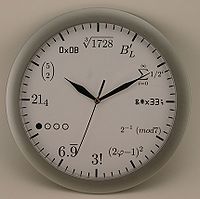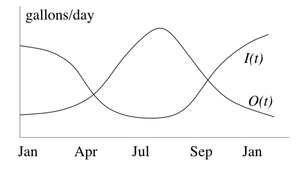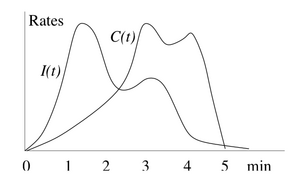Course:MATH103/Archive/2010-2011/207/Lectures/Lecture08
| Faculty of Science Department of Mathematics | |
|---|---|

| |
| Course Pages | |
| Course Policies | |
| Math Solvers | |
| Exams | |
| Quizzes | |
| Assignments | |
| Lectures | |
Lecture 8
Readings For This Lecture
- Chapter 4, pages 71 to 80
Summary
Group 2: Add a summary of the lecture in this space. Include examples, discussion, and links to external sources, if desired.
Exercises
1. The growth rate of a crop is known to depend on temperature during the growing season. Suppose the growth rate of the crop in tons per day is given by
where is temperature in degrees Celsius. Suppose the temperature record during the 90 days of the season was
where is time in days. Find the total growth (in tons) that would have occurred over the whole season.
2. The rate at which water flows in and out of Capilano Reservoir is described by two functions. is the rate at which water flows in to the reservoir (in gallons per day) and is the rate at which water flows out (in gallons per day). See sketch below. Assume that there is water in the reservoir at time . Express the quantity of water in the reservoir as a definite integral. When is the quantity of water in the reservoir greatest and when is it smallest?
| Solution |
|---|
| The greatest quantity of water occurs in April. This is the end of the area where the input curve is above the out flow curve.
The smallest quantity of water occurs in September. This is the end of the area where the out flow curve is above the input curve. |
3. The level of glucose in the blood depends on the rate of intake from ingestion of food and on the rate of clearance due to glucose metabolism. Shown in the figure below are two functions, and for the intake and clearance rates over a period of time after fasting. Both rates are functions of time . Suppose that at time 0 there is no glucose in the blood. Express the level of blood glucose as a definite integral. At what approximate time was the intake rate maximal? At what approximate time was the clearance rate maximal? When was the blood level of glucose maximal?
| Solution |
|---|
| The greatest amount of glucose is at 2.2 minutes. This is the end of the area where the intake curve is above the clearance curve.
The smallest amount of water is at 5 minutes. This is the end of the area where the clearance curve is above the input curve. |
4. Find the average value of the function over the interval .
5. Find the average value of over the interval . What happens as n becomes arbitrarily large (that is, )? Explain your answer by considering the graphs of these functions.
6. Repeat the previous question using the functions .
7. An object starts from rest at and accelerates so that
where is a positive constant. Find the average velocity over the first seconds. What happens to this average velocity as becomes very large?
8. The intensity of light cast by a street lamp at a distance (in meters) along the street from the base of the lamp is found to be approximately in arbitrary units for . Find the value of such that the average intensity over Failed to parse (syntax error): {\displaystyle [−b, b]} is .












![{\displaystyle [0,2]}](https://wiki.ubc.ca/api/rest_v1/media/math/render/svg/120ef5837b0c64a40a2333f5aefd3c36fc458e91)

![{\displaystyle [0,1]}](https://wiki.ubc.ca/api/rest_v1/media/math/render/svg/738f7d23bb2d9642bab520020873cccbef49768d)








